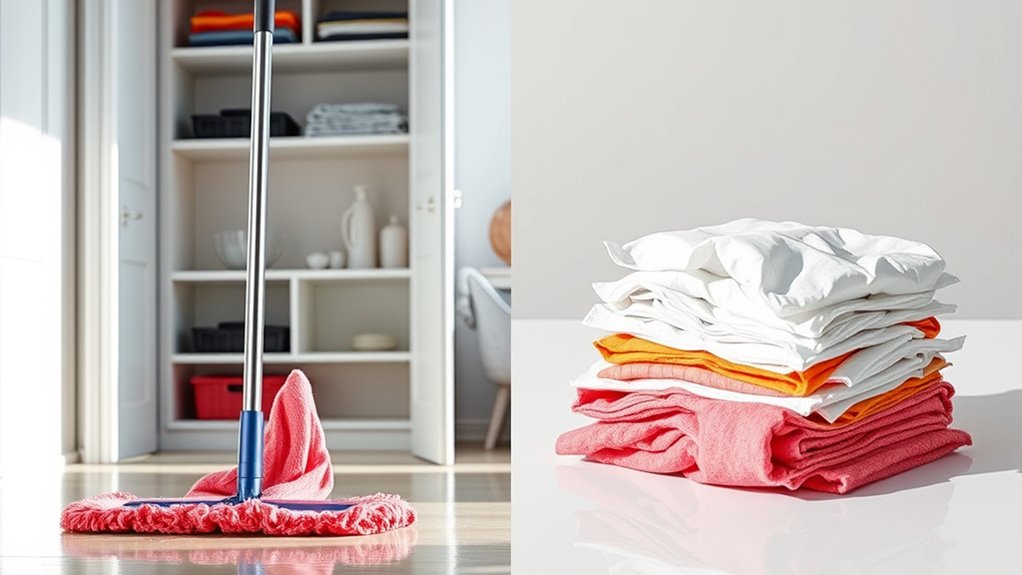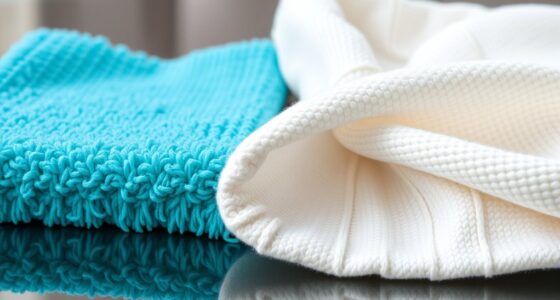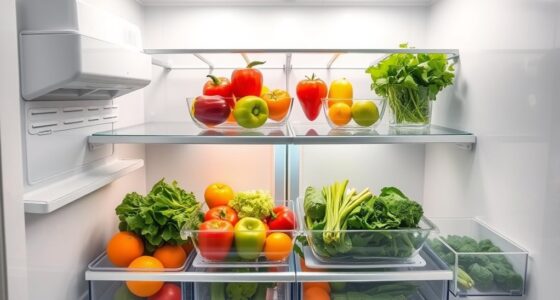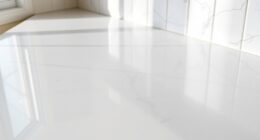Reusable mops and dusters are worth it because they clean more effectively over time, thanks to microfiber technology that traps dust and dirt efficiently. They also reduce waste and are more eco-friendly since you can wash and reuse them many times. While they need regular maintenance, they save you money and help the environment in the long run. To discover how to maximize their benefits, keep exploring how these tools compare directly.
Key Takeaways
- Reusable mops and dusters offer superior cleaning efficiency due to microfiber technology and consistent performance over time.
- They are more environmentally friendly, reducing waste and resource consumption compared to disposable options.
- Reusables require regular washing to maintain hygiene, but properly maintained tools stay effective longer.
- Disposables provide quick, convenient cleaning for single-use tasks but contribute to environmental waste.
- Investing in reusables supports sustainable practices and often results in better long-term cleaning outcomes.
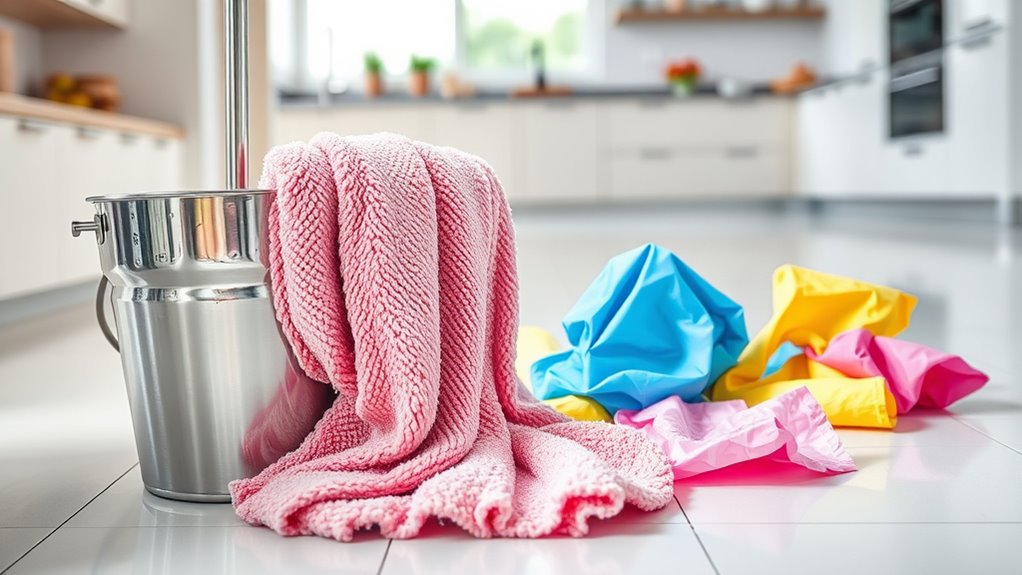
When choosing between reusable and disposable mops and dusters, understanding their differences can help you make a more informed decision. One of the key factors to weigh is cleaning efficiency. Reusable mops and dusters often feature high-quality materials like microfiber, which can trap dust, dirt, and bacteria more effectively than disposable options. These fabrics are designed to pick up more debris with each pass, making your cleaning process quicker and more thorough. Additionally, reusable tools tend to perform consistently over time, provided you maintain and wash them properly. This means that, in the long run, you might spend less time and effort achieving a spotless space. On the other hand, disposable mops and dusters are typically designed for single-use or limited reuse, which can compromise cleaning efficiency over multiple uses. They may not trap dust as effectively after a few uses, leading to more frequent cleaning passes or the need for additional tools.
Reusable mops and dusters with microfiber trap dust more effectively, offering consistent, thorough cleaning over time.
Environmental impact is another vital aspect. Reusable mops and dusters are generally more eco-friendly because they generate less waste. By investing in durable, washable tools, you reduce the number of disposable products ending up in landfills. Over time, this choice considerably lowers your environmental footprint. You also save resources because one reusable item can replace dozens of disposables. Conversely, disposable mops and dusters contribute to waste, often made from non-biodegradable plastics and synthetic fibers that persist in the environment. Their short lifespan means more frequent purchases, which adds to manufacturing emissions and waste. If environmental sustainability matters to you, reusables clearly have the upper hand.
Furthermore, research into sound healing science indicates that environmental choices like using sustainable cleaning tools can contribute to overall well-being by reducing stress and promoting health. However, reusables do require proper maintenance. You need to wash microfiber mops and dusters regularly to keep them effective and hygienic. Failure to do so might diminish their cleaning efficiency and could even lead to bacterial buildup. Disposables, while less sustainable, offer convenience—no washing or maintenance required. They’re ready to use straight out of the package, which is appealing for quick, one-off cleaning tasks or in situations where hygiene is paramount, like in healthcare settings.
Ultimately, the decision depends on your priorities. If you’re focused on long-term cleaning efficiency and minimizing environmental impact, reusable mops and dusters tend to be the smarter choice. They may require an initial investment and some upkeep, but they pay off in durability, performance, and eco-friendliness. If convenience and avoiding maintenance are more important, disposables might suit your needs better. Still, bearing the broader impact in mind, reusables often make the smarter, more sustainable investment for household or commercial cleaning.
Frequently Asked Questions
How Do Reusable Mops Impact Indoor Air Quality?
Reusable mops can positively impact your indoor air quality if you maintain them properly. When cleaned regularly, they reduce airborne allergens and prevent mold growth that can thrive in dirty cloths. However, if not rinsed and dried thoroughly, they might harbor mold and dust, worsening air quality. So, to keep the air clean, make certain your reusable mops are well-maintained and dried after each use.
Are Reusable Dusters Effective for All Surface Types?
Did you know that reusable dusters can pick up 30% more dust than disposable ones? When considering surface compatibility, reusable dusters are versatile, but their cleaning effectiveness depends on the material. They work well on smooth, flat surfaces like glass and countertops, but may struggle with textured or uneven surfaces. To maximize cleaning efficiency, choose a duster suited to your specific surfaces for ideal results.
What Are the Long-Term Environmental Benefits of Reusable Options?
You can improve your home’s sustainability metrics by choosing reusable cleaning tools. Reusable mops and dusters reduce waste and lower the environmental impact, especially when made through eco-friendly manufacturing processes. Over time, you’ll save resources and minimize landfill contributions. Your choice supports a greener future, as reusable options often have a smaller carbon footprint and promote sustainable practices, making them a smart, eco-conscious investment in your cleaning routine.
Do Reusable Mops Require Special Storage or Maintenance?
Storage solutions and sanitation standards shape your reusable mop’s longevity. You’ll need to follow straightforward storage requirements—keeping it dry and in a clean, designated spot to prevent mold and bacteria buildup. Maintenance routines involve regular washing or disinfecting, ensuring your mop remains effective and hygienic. By sticking to simple storage and maintenance routines, you prolong your mop’s lifespan, save money, and sustain sustainable cleaning habits effortlessly.
Can Reusable Mops and Dusters Be Used in Commercial Settings?
You can definitely use reusable mops and dusters in commercial settings, provided you follow proper cleaning protocols. They’re effective for maintaining hygiene and reduce waste, which benefits your cost analysis. Just guarantee you have a reliable system for laundering and sanitizing them regularly. This approach helps you stay compliant with health standards while saving money over time, making reusable tools a smart choice for busy environments.
Conclusion
Ultimately, choosing between reusable and disposable mops and dusters is like selecting between a durable tapestry and a fleeting sketch. Reusables, with their sturdy fibers and endless washes, become trusted companions, absorbing the story of your home. Disposables may fade after a single use, but reusable tools stand resilient, ready to embrace tomorrow’s messes. When you opt for durability and sustainability, you create a cleaner, greener space—where every sweep leaves a lasting impression.

